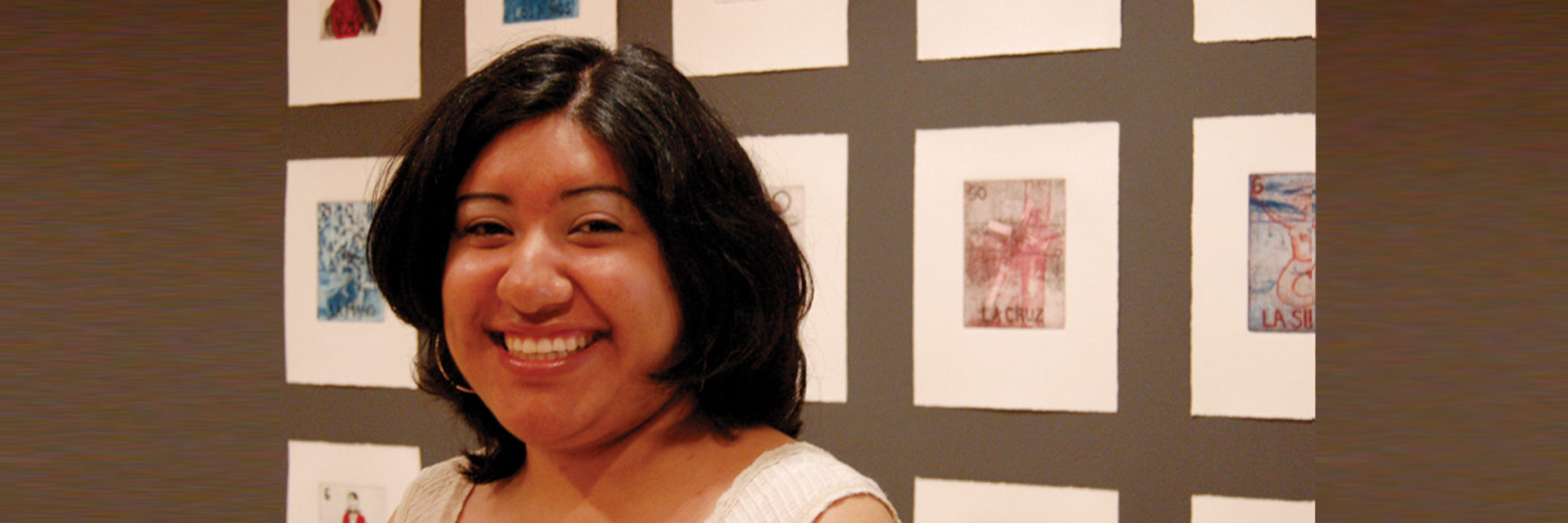The message had gone out early: “All seniors are to vacate their residence halls by 7 p.m. on May 14.” In the early evening after Commencement, as most of the members of Denison’s Class of 2006 hauled a year’s worth of clothing and four years of memories out to their cars, Maritza Bandera and her father were completing a much different task. They were fulfilling her promise to the Burke Hall authorities to repaint from black to its original white the wall on which her senior art exhibit had been hung. It didn’t take too long to complete the job, but the bare wall now seemed stark without Bandera’s 24 colorful, haunting prints that interpret Mexico, the country she calls “home.”
Bandera was born and grew up in Chicago, the younger daughter of Juan and Reyna Bandera, who had come to the United States after their oldest child was born. They had lived in rural southern Mexico where poverty was prevalent and children did not go to school beyond grade two. Juan and Reyna’s goal was to move to the United States where they could work hard and be able to provide their children with the opportunities and education they never had.
From the time she was a little girl, Bandera loved to draw and learned about an after-school art program from her Upward Bound tutor at Edwin G. Foreman High School in Chicago. Through one of her art teachers, she discovered the Posse Program, which matches multicultural teams—or “posses”—of urban public high school leaders with top tier colleges in an effort to promote cross-cultural communication. She eagerly applied and after what seemed like an agonizingly long wait, was overjoyed to learn that she would be in the Chicago posse bound for Granville.
Printmaking was among Bandera’s first courses at Denison in 2002. Almost instantly she knew she had found her artistic calling. She began to carry a notepad and pencil everywhere to jot down ideas about things she saw or read that would make interesting prints. After sketching an image, she would make a plate, roll it through the press in Cleveland Hall and often superimpose another original image with a second roll through the press. She spent every free moment in the print shop, and began to think of it as her second home.
Maritza Bandera’s series of 24 prints are modeled after the popular Mexican game La Loteria, but otherwise depict many of the social ills she observed in her parents’ native country.
That year was one of many discoveries for Bandera. An automobile trip to Mexico for her sister’s wedding gave her the opportunity to experience her parents’ homeland firsthand and she found a deep emotional tie to the country. She ingrained indelible images of children tapping on the car as they begged for pesos, or families hitchhiking rides at night. Her father rejected her pleas to help these people, claiming they were lazy at best and bad-intentioned at worst. She left feeling a need to understand the country and people her parents had left behind.
Despite her father’s misgivings about her safety, Bandera spent spring semester of her junior year with International Studies Abroad in Guanajuato, Mexico. She studied the history of Mexico, Mezzo-American art, Mexican female writers, and printmaking. She traveled over unpaved roads to the southern, underdeveloped, and impoverished states where homes had no indoor plumbing or cooking facilities. The stark contrast to the colonial grandeur and charm of Guanajuato with its European-like plazas, handsome university, and beautiful churches troubled her.
Bandera returned to Denison, determined to make her senior exhibit a visual representation of Mexico’s identity, history, and culture. She wanted to give viewers the sense of chaos, destruction, and contradiction that she believes has resulted from globalization and a corrupt government. Her work, titled Loteria, represents the Mexican bingo game La Loteria which is popular among all Mexican social classes. It originally was composed of hand-painted game boards created by anonymous folk artists during the 19th and early 20th centuries. Bandera’s 24 prints replicate some of the original cards and are overlapped with her own images to reflect her life and experiences. One represents the Mexico City student protest in 1968, which resulted in many deaths, but virtually no social change. Another features a yellow road crossing sign depicting a father, mother, and child crossing the border into America, much like the pedestrian crossing signs seen in the U.S. One shows a skeleton, a popular image representing the holiday Dia de los Muertos, when Mexican families remember their dead and celebrate their children. Still another is of a young Mexican woman who bears a marked resemblance to Bandera, selling calla lilies in a square.
Bandera’s immediate plans don’t put her in Mexico… yet. She expects to work in the Chicago mayor’s office for a few years and earn enough money to go to graduate school. She will continue doing art for her own joy of creation and to improve her skills. But the siren call of Mexico may continue to beckon her, and if she goes, she would like to be able to work in a rural area and take her art to the people who live and work there.
Fleur Metzger is the publications editor at Denison University and an associate editor of this magazine.

